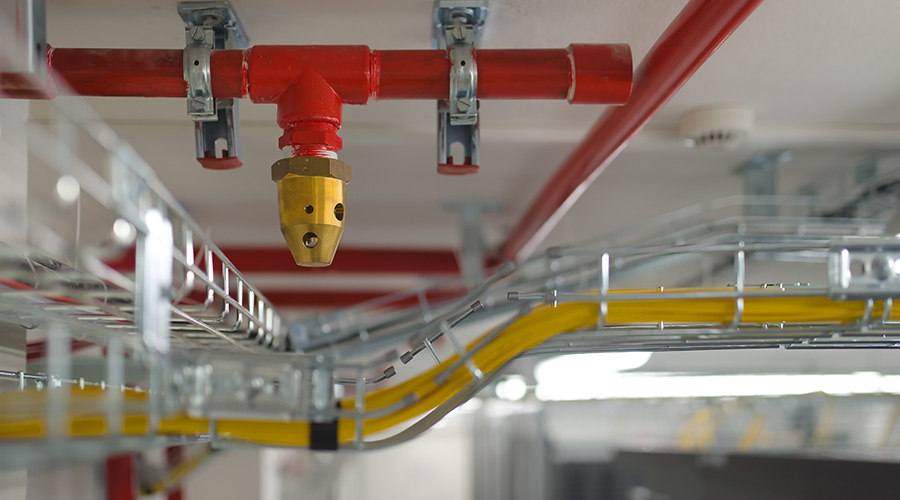Sprinkler System Retrofit Benefits
Weighing the benefits of fire safety systems can seem to be a philosophical exercise, as they are mostly benefits a facility will hopefully never take advantage of. But once a fire breaks out, the benefits are obvious. According to the National Fire Protection Association (NFPA), damage costs per fire are lower by 40 to 70 percent in sprinklered facilities, for most property types. According to NFPA data, between 2003 and 2007, damage costs per fire without a sprinkler system totaled $44,000 in stores/offices, $18,000 in educational facilities and $8,000 in health care facilities. With sprinklers, the damages per fire were $26,000, $7,000 and $3,000, respectively. And this is of course to say nothing of the incalculable benefit of saving lives.
There are benefits beyond life safety, Gardner says. For example, different interior finishes are allowed when a space is sprinklered. Also a recent study by FM Global, which looked at the green impact of fire sprinklers, found that they can cut greenhouse gas emissions from a fire by up to 98 percent. They also mitigate the amount of water pollution released into the environment.
Unlike energy-saving retrofits — a new lighting system, for example — fire safety systems are not among the quick-win strategies for cost savings. But some savings are available right off the bat, chiefly through insurance rate reductions. In his report, "Fire Sprinklers Save Lives and Money: The Economics of Retrofit," Isman estimates that with a sprinkler system an office building can reap a 46 percent reduction in insurance cost for the building and 43 percent reduction for the contents. This estimate is based on a 10-year-old, 10-story, 110,000-square-foot masonry-construction facility with typical contents and occupancy.
The trick to cashing in on this benefit is to keep up with annual inspections and testing and to make sure the results are sent to the insurance company. Once a facility is overdue by a year for its inspection, the rates start to climb back up, typically by 5 percent the first year, 20 percent the second year and back to unsprinklered rates once a facility is overdue by three years or more.
Other immediate savings are available through income tax deductions.
Code Requirements
Most retrofits happen because code requires buildings owners to act. With more than 15,000 individual local building codes nationwide, it has been up to local jurisdictions to adopt sprinkler retrofit requirements. And it usually has taken a catastrophic fire for a jurisdiction to pass retrofit laws.
In 1973, with Local Law 5, New York City became the first large urban area in the United States to have code language requiring fire sprinkler retrofit for office high rises, but the law didn't go into effect until 1978 after a legal battle ending in the New York State Supreme Court.
Today, all major cities require sprinkler retrofits for high-rise buildings except for Chicago, says Isman. However, a 2004 Chicago city ordinance calls for all high-rise commercial buildings constructed before 1975 to have automatic fire sprinklers by 2017.
Besides legal mandate, other drivers of retrofits include insurance benefits and tenant demand. Also, whenever a facility changes occupancy or undergoes a total renovation, codes will apply as if the building was a brand new building, forcing a retrofit, says Gardner.
|

Photographs of dorm rooms show the results of an experiment conducted by the National Institute of Standards and Technology (NIST) at the University of Arkansas. The room in the top photo had a sprinkler; there was no sprinkler in the room in the lower picture. NIST researchers found the automatic fire sprinklers activated within two minutes after ignition of the fire and kept the dorm room and the corridor safe.
The results of two NIST studies, "Impact of Sprinklers on the Fire Hazard in Dormitories: Sleeping Room Fire Experiments" and "Impact of Sprinklers on the Fire Hazard in Dormitories: Day Room Fire Experiments" are available at www.nist.gov/cgi-bin//get_pdf.cgi?pub_id=904640 and www.nist.gov/cgi-bin//get_pdf.cgi?pub_id=101409 respectively.
— Naomi Millán
|
|
MYTH BUSTER
Water, Water, Everywhere?
Counter to what Hollywood loves to portray, sprinkler heads are activated individually by the heat of the fire only, not by smoke, nor do they release in unison across the entire system. In most fires, fewer than four sprinkler heads activate. The intent is to contain the fire to give the fire department time to arrive on site, though most fires are also suppressed by the fire sprinkler system.
The potential for water damage is sometimes a deterrent to property owners when considering a sprinkler system. "And what will the fire fighters do if you don't have sprinklers?" says Hamid Bahadori, principal with Hughes Associates. "With a sprinkler system, the water damage is much less." A typical sprinkler head discharges about 20 to 25 gallons per minute (GPM), though ESFR (early suppression fast response) systems designed for warehouses can discharge 100 GPM. A fire hose delivers 100 to 250 GPM.
Bahadori adds that sprinkler systems are usually tied to the fire alarm system, which automatically sends a signal to the fire department via a central monitoring station. This combination means fire fighters get there sooner and have to fight a smaller fire — if it's even still burning by the time they arrive — so less water is needed.
— Naomi Millán
|
Related Topics:














